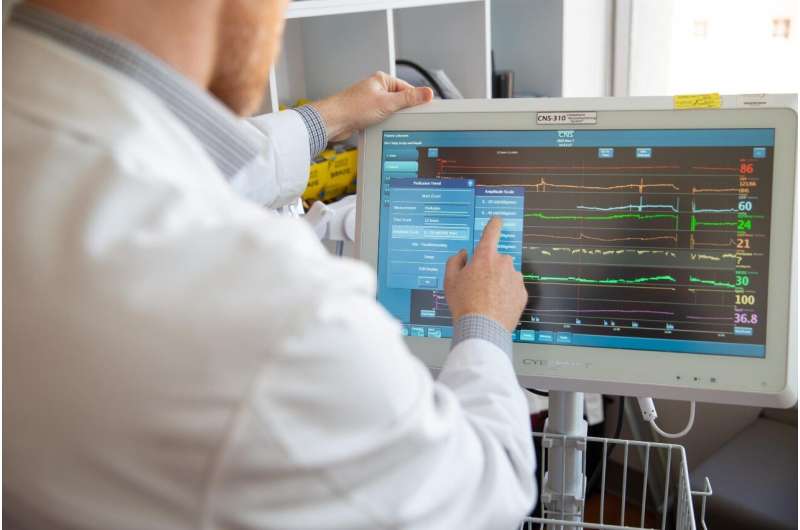Learn about brain health and nootropics to boost brain function
Using a neuromonitoring platform to improve care for traumatic brain injuries

UC’s neurocritical care team monitors metrics like blood flow, pressure, oxygen and glucose levels in the brain in real time and monitors trends and spikes over longer periods of time for patients with severe traumatic brain injuries. Credit: Andrew Higley/UC Marketing + Brand. Tracking heart rate, blood pressure and oxygen levels is a standard practice to give doctors valuable information on patients’ heart and lung health over time and guide treatment decisions.
The University of Cincinnati Gardner Neuroscience Institute’s Brandon Foreman, MD, said there is a need for similar tracking of data on patients’ brain health for those with severe brain injuries. UC experts have pioneered a comprehensive platform for this practice known as multimodal neuromonitoring (MNM), despite a lack of standard practice among others in the field.
Foreman, along with an international panel of colleagues and experts in MNM, recently published survey results in the journal Critical Care Medicine identifying areas of consensus and needs for further research to develop a standard practice for comprehensively monitoring brain health in the intensive care unit . MNM basics
Foreman said measurements like blood flow, pressure, oxygen and glucose levels in the brain give actionable information when treating patients with severe brain trauma.
“We can give people oxygen, we can give people glucose, we can reduce pressure inside the skull,” said Foreman, associate professor of neurology and associate director of neurocritical care research in the Department of Neurology and Rehabilitation Medicine in UC’s College of Medicine and a UC Health physician. “Multimodal brain monitoring is all about getting those measurements that give us the same comprehensive view of the brain that we normally get from the vital signs that help monitor the heart and lungs.”
Many of these brain metrics require neurosurgeons to place advanced catheters in patients’ brains, so MNM typically only occurs in academic institutions where there are available technologies and surgeons with this expertise.
At UC, MNM efforts are focused on patients with traumatic brain injuries. Led by Laura Ngwenya, MD, director of the UCGNI Neurotrauma Center, neurosurgeons are trained to place brain monitors directly into the brain at bedside early after patients come to the intensive care unit. The neurocritical team has developed a unique and comprehensive system where all of the brain measurements are then aggregated into a single platform to help inform their medical decisions.
“We decided if we’re going to put something in your head, we probably should do it in the most comprehensive way possible because this is not a benign thing to do,” Foreman said. “There’s no one else that monitors the brain to the degree that we do. There’s nowhere else that does this.”
Foreman said he can remotely monitor patient data on the platform from anywhere at any time, and the platform also helps the team track changes over longer periods of time.
“If a patient is in the ICU at 2 a.m., I can pull up everything that’s happening in real time and help the team there at the bedside make a decision,” he said. “We also implemented this strategy so over time we see how the brain injury is evolving—how this person’s brain is really working or not working. That helps direct the team in terms of the things that they want to do to address problems at the bedside.” Next steps
Foreman said survey results from 35 experts in MNM across the country found agreement that the practice of MNM can help care teams make better treatment decisions, including choosing not to intervene when doing so could be harmful. Having more comprehensive data allows for personalized care based on each patient’s individual needs.
The experts agreed MNM is best used for the “sickest of the sick” patients, like those with traumatic brain injuries and severe strokes, but there is currently not enough data to determine other patient populations that may benefit from MNM. Most survey participants also agreed that MNM is a distinct specialty that will require specific training and expertise rather than just involving buying a high-tech piece of equipment and plugging it in.
“I think there’s a movement toward this being its own entity, something that you would train on as a separate skill, that you’d deploy as a separate line of service,” Foreman said.
All of the data and best equipment in the world is worthless if it doesn’t lead to better treatment for patients, so Foreman said an important step of standardizing MNM will be to prove its usefulness. But how MNM is used depends on how the data is interpreted by experts in order to provide clinical care teams with the right information for decision making. Foreman and the UC neurocritical care team’s pioneering approach has now been adopted at several academic centers across the US.
This year, Rudy Luna, MD, a first-year neurology resident at UC, presented research at the American Academy of Neurology conference that found “a significant shift toward improvement in clinical outcome” for patients with daily reporting and interpretation of MNM data. Foreman said the team is writing a more comprehensive analysis that he hopes to publish in the coming months that confirms the usefulness of MNM to improve the outcome of patients at UC with severe traumatic brain injuries.
Provided by University of Cincinnati
Read more at medicalxpress.com